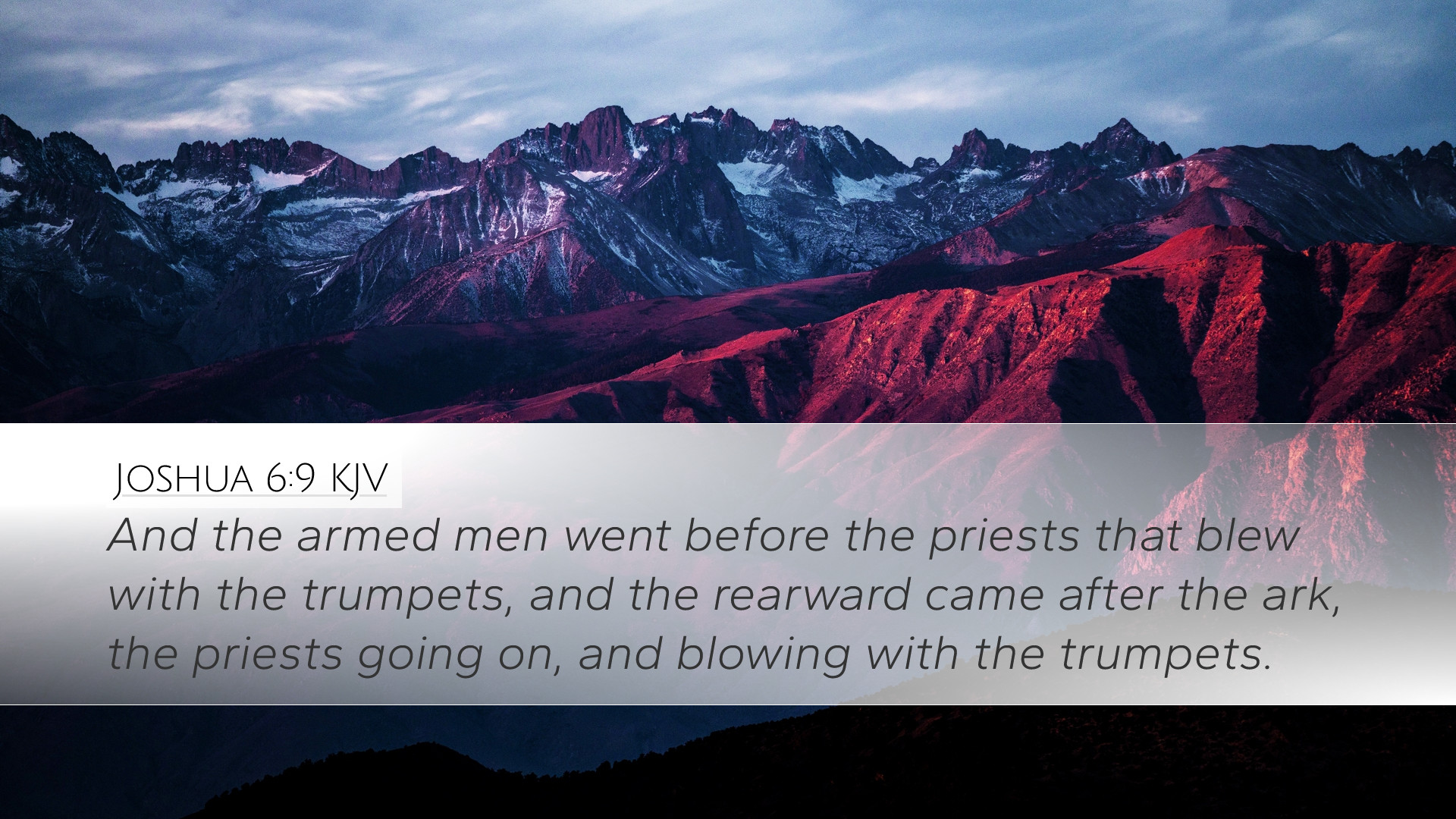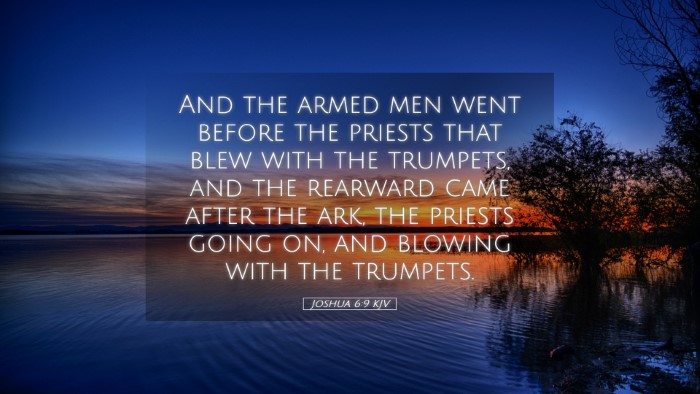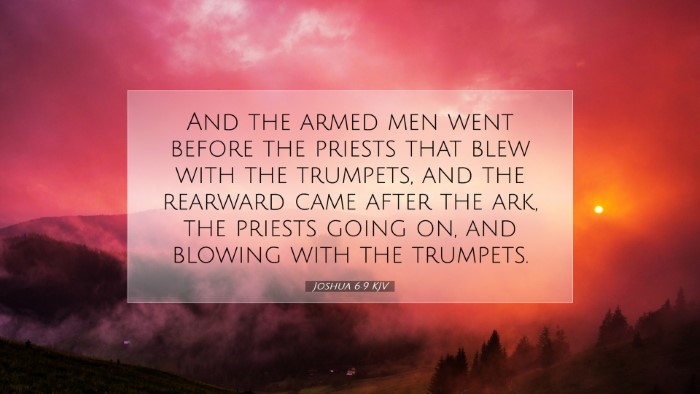Commentary on Joshua 6:9
Verse: "And the armed men went before the priests that blew with the trumpets, and the rearward came after the ark, the priests going on, and blowing with the trumpets." (Joshua 6:9)
Introduction
This verse captures a pivotal moment in the conquest of Jericho, showcasing the strategy and divine instruction given to the Israelites as they prepared to take the city. It emphasizes the organized approach of Israel’s army and the central role of the priests and the Ark of the Covenant in their march, denoting a spiritual and physical preparation for battle.
Context and Significance
The walls of Jericho were formidable, yet the Israelites were commanded to take them not through traditional warfare but by faith and obedience (Hebrews 11:30). The passage illustrates the practice of divine orders being executed with meticulous attention to detail, echoing themes of faith leading to victory. The order of march, with armed men in the front, the priests blowing trumpets, and the Ark in the center, signifies a structured approach rooted in God’s command.
Insights from Matthew Henry
Matthew Henry highlights the significance of the armed men preceding the priests. He notes that this positioning symbolizes both physical readiness for battle and spiritual leadership. The priests, while responsible for the spiritual aspects of the march, were also supported by those ready to fight, showcasing a balance between the sacred and the secular.
Henry also emphasizes the act of blowing the trumpets as a form of proclamation, signifying the presence of God among His people. This heralding served both as a communication of God’s presence and as a sound of warning to the inhabitants of Jericho. It indicates that the God of Israel was on the move, preparing to assert His authority over the land.
Insights from Albert Barnes
Albert Barnes draws attention to the arrangement of the march and suggests that it was not just a military tactic but a representation of God’s order and the importance of following His divine instructions in every aspect of life. Barnes notes that the priests bore the Ark of the Covenant, signifying the covenant relationship between God and Israel, which was central to their identity as a people chosen by God.
Barnes elaborates on the sounding of the trumpets, relating it to the ancient custom where trumpets were used for both announcements of war and celebrations of victories. This dual purpose underscores the seriousness of the undertaking ahead, coupled with a reminder of God’s faithfulness to Israel throughout their journey.
Insights from Adam Clarke
Adam Clarke provides a deep dive into the ceremonial implications of this event. He points out that the presence of armed men along with the priests illustrates a profound truth: that spiritual leadership and military action can and should coexist in the pursuit of God's purposes. Clarke asserts that the armed men protecting the priests indicates a safeguard for the spiritual leaders while performing their sacred duties, emphasizing a community action in faith.
Clarke also discusses the significance of following God’s command with diligence and faith, an essential lesson for contemporary believers. He states that, through obedience to God and reliance on His presence, triumph over challenges is guaranteed, reinforcing the narrative that true victory comes from a collaboration between divine instruction and human action.
Theological Themes
- Divine Instruction and Obedience: This narrative emphasizes the necessity of obedience to God’s commands. The specificity of the instructions given to Joshua and the people illustrates that God’s methods may differ from human expectations, demanding faith from His followers.
- The Role of Worship in Warfare: The priests blowing trumpets represents worship intertwined with spiritual warfare. The acknowledgment of God's presence through worship becomes an essential part of the Israelites’ strategy, indicative of the belief that battles are fought on spiritual grounds first.
- Community and Leadership: The structure of the army, with the priests and armed men working together, symbolizes the need for collaborative efforts in ministry. It serves as a prototype for contemporary church leadership, where spiritual and temporal leaders must unite in their mission.
Application for Today’s Believers
This verse and its surrounding context invite today’s believers to reflect on their spiritual lives and the nature of their obedience. There are several applications:
- Leadership in the Church: Just as the priests and armed men complemented each other, so must church leaders today work in harmony, relying on both spiritual insight and practical action to lead their congregations effectively.
- Faith in Action: Believers are reminded that faith is not a passive state but requires action and obedience, much like the Israelites had to actively follow God’s instructions to achieve victory.
- Worship as Warfare: The practice of worship should be at the forefront of our lives, particularly in challenging circumstances. Worship serves not only as a means of honoring God but also as a powerful weapon against the adversities faced.
Conclusion
Joshua 6:9 stands as a testimony to the might of God in the lives of His people through organized faith and obedience. The wisdom gathered from the commentaries of Henry, Barnes, and Clarke collectively highlight that understanding the historical context, spiritual symbolism, and practical applications lead to a profound appreciation for Scripture. As modern-day believers reflect on this passage, they are encouraged to embrace both the divine directives and the roles they play in the unfolding narrative of God’s redemptive plan.


